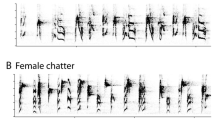Summary
Live and stuffed male and female red-winged blackbirds (Agelaius phoeniceus) were presented to territorial males in order to study the repertoire organization of males during intersexual and intrasexual encounters. Territorial male red-winged blackbirds switched song types more frequently and sang more song types in response to presentation of a female stimulus than during control periods, but decreased their switching frequency when a male stimulus was presented. Switching frequency in response to the female stimulus was three times that in response to the male stimulus. These results support the hypothesis that song repertoires of male red-winged blackbirds evolved primarily in response to intersexual rather than intrasexual selection. They also suggest that male red-winged blackbirds have been selected to de-emphasize their song repertoires during encounters with conspecific males as a result of some as yet unidentified cost.
Similar content being viewed by others
References
Catchpole CK (1980) Sexual selection and the evolution of complex songs among European warblers of the genus Acrocephalus. Behaviour 74:149–166
Catchpole CK (1982) The evolution of bird sounds in relation to mating and spacing behavior. In: Kroodsma DE, Miller EH, Oullet H (eds) Acoustic communication in birds, vol 1. Academic Press, New York, pp 297–319
Catchpole CK (1987) Bird song, sexual selection and female choice. Trends Ecol Evol 2:94–97
Catchpole CK, Leisler B, Dittami J (1986) Sexual differences in the response of captive great reed warblers (Acrocephalus arundinaceus) to variation in song structure and repertoire size. Ethology 73:69–77
D'Agincourt LG, Falls JB (1983) Variation of repertoire use in the eastern meadowlark, Sturnella magna. Can J Zool 61:1086–1093
Derrickson KC (1987) Yearly and situational changes in the estimate of repertoire size in northern mockingsbirds (Mimus polyglottos). Auk 104:198–207
Derrickson KC (1988) Variation in repertoire presentation in northern mockingbirds. Condor 90:592–606
Falls JB, D'Agincourt LG (1982) Why do meadowlarks switch song types? Can J Zool 60:3400–3408
King AP, West MJ (1977) Species identification in the North American cowbird: appropriate responses to abnormal song. Science 195:1002–1004
King AP, West MJ, Eastzer DH, Staddon JER (1981) An experimental investigation of the bioacoustics of cowbird song. Behav Ecol Sociobiol 9:211–217
Kramer HG, Lemon RE (1983) Dynamics of territorial singing between neighboring song sparrows (Melospiza melodia). Behaviour 86:198–223
Kramer HG, Lemon RE, Morris MJ (1985) Song switching and agonistic stimulation in the song sparrow (Melospiza melodia): five tests. Anim Behav 33:135–149
Krebs JR, Kroodsma DE (1980) Repertoires and geographical variation in bird songs. Adv Study Behav 11:143–177
Kroodsma DE, Verner J (1978) Complex singing behaviors among Cistothorus wrens. Auk 95:703–716
Nero RW (1956) A behavior study of the red-winged blackbird. I. Mating and nesting activities. Wilson Bull 68:5–37
Orians GH, Christman GM (1968) A comparative study of the behavior of red-winged, tricolored, and yellow-headed blackbirds. Univ Calif Publ Zool 84:1–81
Searcy WA (1988) Dual intersexual and intrasexual functions of song in red-winged blackbirds. Proc XIX Int Congr Ornithol 1:1373–1381
Searcy WA (1989) Functions of courtship vocalizations in red-winged blackbirds. Behav Ecol Sociobiol 24:325–331
Searcy WA, Andersson M (1986) Sexual selection and the evolution of song. Annu Rev Ecol Syst 17:507–533
Searcy WA, Yasukawa K (1983) Sexual selection and red-winged blackbirds. Am Sci 71:166–174
Simpson BS (1985) Effects of location in territory and distance from neighbors on the use of song repertoires by Carolina wrens. Anim Behav 33:793–804
Smith DG (1972) The role of the epaulets in the red-winged blackbird (Agelaius phoeniceus) social system. Behaviour 41:251–268
Smith DG, Reid FA (1979) Roles of the song repertoire in red-winged blackbirds. Behav Ecol Sociobiol 5:279–290
West MJ, King AP (1980) Enriched cowbird song by social deprivation. J Comp Physiol Psychol 94:263–270
West MJ, King AP, Eastzer DH, Staddon JER (1979) A bioassay of isolate cowbird song. J Comp Physiol Pyschol 93:124–133
West MJ, King AP, Eastzer DH (1981) Validating the female bioassay of cowbird song: relating differences in song potency to mating success. Anim Behav 29:490–501
Yasukawa K (1981) Song repertoires in the red-winged blackbird (Agelaius phoeniceus): a test of the Beau Geste hypothesis. Anim Behav 29:114–125
Author information
Authors and Affiliations
Additional information
Offprint requests to: W.A. Searcy
Rights and permissions
About this article
Cite this article
Searcy, W.A., Yasukawa, K. Use of the song repertoire in intersexual and intrasexual contexts by male red-winged blackbirds. Behav Ecol Sociobiol 27, 123–128 (1990). https://doi.org/10.1007/BF00168455
Received:
Accepted:
Issue Date:
DOI: https://doi.org/10.1007/BF00168455




